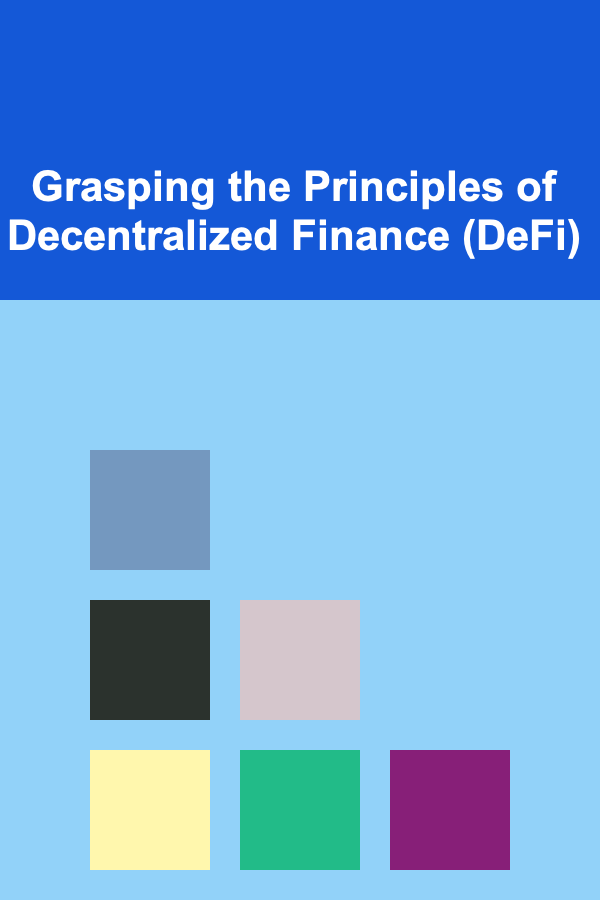
Grasping the Principles of Decentralized Finance (DeFi)
ebook include PDF & Audio bundle (Micro Guide)
$12.99$6.99
Limited Time Offer! Order within the next:

Decentralized Finance (DeFi) is revolutionizing the financial landscape, promising a more accessible, transparent, and efficient system compared to traditional finance (TradFi). However, navigating the complex world of DeFi requires a solid understanding of its core principles and underlying technologies. This article provides a comprehensive exploration of these principles, offering a roadmap for anyone seeking to grasp the fundamentals of DeFi.
What is Decentralized Finance?
At its core, DeFi aims to recreate and improve upon traditional financial services using decentralized technologies, primarily blockchain. Instead of relying on intermediaries like banks and brokers, DeFi utilizes smart contracts to automate and execute financial agreements. This disintermediation reduces costs, increases speed, and potentially empowers individuals with greater control over their finances.
DeFi encompasses a wide range of applications, including:
- Decentralized Exchanges (DEXs): Platforms for trading cryptocurrencies directly with other users, eliminating the need for a central authority.
- Lending and Borrowing Platforms: Protocols that allow users to lend and borrow cryptocurrencies, earning interest or accessing capital without traditional credit checks.
- Stablecoins: Cryptocurrencies designed to maintain a stable value, often pegged to a fiat currency like the US dollar, providing price stability for DeFi applications.
- Yield Farming: A strategy for maximizing cryptocurrency holdings by lending or staking them in DeFi protocols to earn rewards.
- Derivatives: Financial contracts whose value is derived from an underlying asset, such as options and futures contracts for cryptocurrencies.
- Insurance: Decentralized insurance protocols offering coverage against various risks in the DeFi space, such as smart contract vulnerabilities.
- Asset Management: Tools and protocols for managing cryptocurrency portfolios and automating investment strategies.
Core Principles of DeFi
Understanding the following core principles is essential for navigating the DeFi landscape:
1. Decentralization
The cornerstone of DeFi is decentralization, which means distributing control and decision-making power across a network rather than concentrating it in a single entity. This is achieved through blockchain technology, which provides a shared, immutable, and transparent ledger of transactions.
Key aspects of decentralization in DeFi:
- No Central Authority: DeFi protocols operate without a central intermediary, eliminating the need for trust in a single entity.
- Distributed Governance: Decision-making is often governed by token holders, who can vote on proposals and influence the future direction of the protocol.
- Open Source Code: DeFi projects are typically built on open-source code, allowing anyone to inspect, audit, and contribute to the development of the protocol.
- Permissionless Access: Anyone with an internet connection and a compatible wallet can access and use DeFi protocols, regardless of their location or background.
While complete decentralization is an ideal, many DeFi projects operate on a spectrum of decentralization. Some may have centralized elements, such as development teams or governance structures, while others strive for greater levels of decentralization over time.
2. Transparency
Transparency is another crucial principle of DeFi. Blockchain technology allows for all transactions to be publicly viewable and auditable on the blockchain. This transparency reduces the risk of fraud and manipulation and promotes accountability.
Benefits of transparency in DeFi:
- Auditable Transactions: All transactions are recorded on the blockchain and can be independently verified by anyone.
- Smart Contract Visibility: The code that governs DeFi protocols is typically open-source, allowing users to understand how the system works and identify potential vulnerabilities.
- Real-Time Data: Users have access to real-time data on asset prices, trading volumes, and other key metrics, enabling them to make informed decisions.
However, while transactions are transparent, user identities are often pseudonymous. This means that transactions are linked to wallet addresses rather than personal information, providing a degree of privacy while maintaining transparency.
3. Composability
Composability, often referred to as "money legos," is the ability of DeFi protocols to interact and integrate with each other seamlessly. This allows developers to build complex financial applications by combining different DeFi building blocks.
Examples of composability in DeFi:
- Using a DEX to Swap Tokens and then Depositing them into a Lending Protocol: Users can easily swap tokens on a DEX like Uniswap and then deposit those tokens into a lending protocol like Aave to earn interest.
- Creating Collateralized Debt Positions (CDPs) using Different Stablecoins: Users can create CDPs using various stablecoins, allowing for greater flexibility and diversification.
- Building Automated Trading Strategies using Multiple DeFi Protocols: Developers can create automated trading strategies that interact with multiple DeFi protocols to optimize returns.
Composability fosters innovation and accelerates the development of new DeFi applications. It allows developers to leverage existing infrastructure and create increasingly sophisticated financial services.
4. Permissionless Access
DeFi protocols are generally permissionless, meaning that anyone can access and use them without needing to obtain permission from a central authority. This democratizes access to financial services and promotes inclusivity.
Advantages of permissionless access in DeFi:
- Global Accessibility: Anyone with an internet connection can access DeFi protocols, regardless of their location or background.
- Financial Inclusion: DeFi can provide financial services to underserved populations who may not have access to traditional banking systems.
- Innovation and Competition: Permissionless access fosters innovation and competition, as anyone can build and deploy new DeFi applications.
However, permissionless access also comes with risks, such as the potential for scams and malicious actors to exploit vulnerabilities in DeFi protocols. Users should exercise caution and conduct thorough research before interacting with any DeFi protocol.
5. Smart Contracts
Smart contracts are self-executing contracts written in code that automatically enforce the terms of an agreement. They are the foundation of DeFi, enabling the automation and decentralization of financial services.
Key features of smart contracts in DeFi:
- Automation: Smart contracts automatically execute the terms of an agreement when pre-defined conditions are met, eliminating the need for manual intervention.
- Immutability: Once deployed, smart contracts cannot be altered, ensuring that the terms of the agreement remain unchanged.
- Transparency: The code of a smart contract is typically open-source, allowing users to understand how the contract works.
- Trustlessness: Smart contracts eliminate the need for trust in a central intermediary, as the terms of the agreement are enforced by the code itself.
Understanding how smart contracts work is crucial for understanding how DeFi protocols function. However, smart contracts are also vulnerable to bugs and exploits, which can lead to financial losses. Users should be aware of these risks and take steps to mitigate them, such as using audited and reputable DeFi protocols.
6. Open Source
The majority of DeFi projects embrace open-source principles. This means the code is publicly available, allowing anyone to inspect, modify, and distribute it. This fosters collaboration, transparency, and security.
Benefits of Open Source in DeFi:
- Enhanced Security: Open-source code can be reviewed by a large community of developers, increasing the likelihood of identifying and fixing bugs.
- Innovation and Collaboration: Open-source code allows developers to build upon existing projects and create new and innovative applications.
- Transparency and Trust: Open-source code allows users to understand how the system works and verify its integrity.
- Forkability: Open-source code can be forked, allowing developers to create their own versions of a project with different features or governance models.
However, open-source code also comes with risks. Malicious actors can use open-source code to identify vulnerabilities and create exploits. Users should exercise caution and conduct thorough research before interacting with any DeFi protocol.
Understanding the Technology Stack
To truly grasp DeFi, understanding the underlying technology stack is crucial. This stack consists of several layers, each playing a critical role in the ecosystem.
1. Blockchain Layer (Layer 1)
The foundation of DeFi is the blockchain, which provides the underlying infrastructure for decentralized transactions and data storage. Ethereum is the most popular blockchain for DeFi applications, but other blockchains like Solana, Cardano, and Avalanche are also gaining traction.
Key considerations for Layer 1 blockchains in DeFi:
- Scalability: The ability to handle a large number of transactions per second (TPS) is crucial for DeFi protocols to function efficiently.
- Security: The security of the blockchain is paramount, as any vulnerabilities can be exploited to steal funds.
- Transaction Fees: High transaction fees can make DeFi protocols expensive to use, hindering adoption.
- Smart Contract Functionality: The blockchain must support smart contracts to enable the automation and decentralization of financial services.
2. Smart Contract Layer (Layer 2)
The smart contract layer consists of the code that governs DeFi protocols. Smart contracts are deployed on the blockchain and automatically execute the terms of an agreement when pre-defined conditions are met.
Key considerations for smart contracts in DeFi:
- Security: Smart contracts are vulnerable to bugs and exploits, which can lead to financial losses. Auditing by reputable firms is critical.
- Efficiency: Smart contracts should be written efficiently to minimize gas costs and maximize performance.
- Upgradability: Smart contracts should be designed to be upgradable to allow for bug fixes and new features.
- Formal Verification: Formal verification techniques can be used to mathematically prove the correctness of smart contracts.
3. Application Layer
The application layer consists of the user-facing applications that interact with DeFi protocols. These applications provide users with a way to access and use DeFi services, such as trading on DEXs, lending and borrowing cryptocurrencies, and participating in yield farming.
Key considerations for application layer in DeFi:
- User Experience (UX): DeFi applications should be user-friendly and easy to use, even for those who are new to the space.
- Security: DeFi applications should be designed to protect users from phishing attacks and other security threats.
- Integration: DeFi applications should be able to seamlessly integrate with other DeFi protocols to provide a more comprehensive user experience.
- Access Control: Implementing robust access control mechanisms to ensure only authorized users can perform certain actions.
4. Data and Oracle Layer
Many DeFi applications rely on external data to function correctly. For example, a lending protocol needs to know the price of collateral assets to determine whether a loan is undercollateralized. Oracles are used to bring external data onto the blockchain in a reliable and secure manner.
Key considerations for Data and Oracle layer in DeFi:
- Accuracy: Oracles should provide accurate and reliable data to ensure that DeFi protocols function correctly.
- Security: Oracles are vulnerable to manipulation, which can lead to financial losses.
- Decentralization: Decentralized oracles are more resistant to censorship and manipulation.
- Cost: Using oracles can be expensive, especially for applications that require frequent data updates.
Risks of DeFi
While DeFi offers many potential benefits, it is also important to be aware of the risks involved.
- Smart Contract Risk: Smart contracts are vulnerable to bugs and exploits, which can lead to financial losses.
- Impermanent Loss: Liquidity providers in DEXs can experience impermanent loss, which is the loss of value when the price of the deposited tokens diverges.
- Rug Pulls: Malicious actors can create DeFi projects with the intention of stealing users' funds and disappearing ("rug pull").
- Volatility: The value of cryptocurrencies can be highly volatile, which can lead to significant gains or losses.
- Regulatory Uncertainty: The regulatory landscape for DeFi is still evolving, and there is a risk that governments could impose regulations that restrict or prohibit the use of DeFi protocols.
- Systemic Risk: The interconnectedness of DeFi protocols can create systemic risk, where a failure in one protocol can trigger a cascade of failures in other protocols.
- Oracle Manipulation: Oracles are vulnerable to manipulation, which can lead to inaccurate data and financial losses.
Before investing in DeFi, it is essential to conduct thorough research, understand the risks involved, and only invest what you can afford to lose.
Navigating the DeFi Landscape: Practical Steps
Here's a step-by-step guide to help you navigate the DeFi landscape:
1. Educate Yourself
Start by learning the fundamentals of blockchain technology, cryptocurrencies, and smart contracts. There are many resources available online, including articles, tutorials, and courses.
2. Choose a Reputable Wallet
Select a reputable cryptocurrency wallet that supports DeFi protocols. Popular wallets include MetaMask, Trust Wallet, and Ledger.
3. Understand Gas Fees
Familiarize yourself with gas fees, which are the transaction fees required to execute smart contracts on the blockchain. Gas fees can fluctuate significantly, so it's important to understand how they work and how to minimize them.
4. Start Small
Begin with small amounts of capital and gradually increase your investments as you become more comfortable with DeFi protocols.
5. Research DeFi Protocols
Conduct thorough research on any DeFi protocol before investing. Look for audited protocols with a strong track record.
6. Diversify Your Portfolio
Diversify your DeFi portfolio to reduce risk. Don't put all your eggs in one basket.
7. Stay Informed
Stay up-to-date on the latest developments in the DeFi space. Follow reputable news sources and thought leaders.
8. Use Security Best Practices
Protect your wallet with strong passwords and two-factor authentication. Be wary of phishing attacks and never share your private keys with anyone.
9. Use Testnets
Whenever possible, use testnets to experiment with new DeFi protocols before using real funds. Testnets are simulated blockchain environments that allow you to test smart contracts without risking real money.
10. Understand the Liquidity Pool risks
When participating in liquidity pools, be aware of Impermanent Loss. This loss is the difference between holding tokens in a liquidity pool versus simply holding them in your wallet. Understanding the potential for this loss is crucial for successful yield farming.
The Future of DeFi
DeFi is still in its early stages, but it has the potential to transform the financial industry. As the technology matures and adoption grows, we can expect to see even more innovative and sophisticated DeFi applications emerge. Some potential future developments include:
- Increased Scalability: Layer 2 solutions and other scalability technologies will enable DeFi protocols to handle a larger number of transactions per second.
- Improved User Experience: DeFi applications will become more user-friendly and accessible to a wider audience.
- Greater Interoperability: DeFi protocols will become more interoperable with each other and with traditional financial systems.
- More Sophisticated Financial Products: DeFi will enable the creation of more sophisticated financial products, such as decentralized insurance and derivatives.
- Institutional Adoption: Institutional investors will increasingly adopt DeFi as they become more comfortable with the technology and regulatory environment.
- Regulation: Clearer regulatory frameworks will emerge, providing greater certainty and encouraging innovation in the DeFi space.
Conclusion
DeFi is a rapidly evolving and complex field, but understanding its core principles is essential for anyone seeking to participate in this revolutionary new financial system. By grasping the concepts of decentralization, transparency, composability, permissionless access, and smart contracts, you can navigate the DeFi landscape with greater confidence and make informed decisions. Remember to always do your own research, manage your risk, and stay informed about the latest developments in the DeFi space. As DeFi continues to evolve, it promises to reshape the future of finance, offering a more accessible, transparent, and efficient system for everyone.

Creating a Digital Journaling Course: An Actionable Guide
Read More
How To Join Online Language Learning Communities
Read More
How to Keep Your Garage Organized with Creative Storage Ideas
Read More
How to Maximize Your Budget for Home Lighting Ideas
Read More
How to Train Your Dog to Help with Home Security
Read More
How To Discover the Lost City of Atlantis (Debunking Myths)
Read MoreOther Products

Creating a Digital Journaling Course: An Actionable Guide
Read More
How To Join Online Language Learning Communities
Read More
How to Keep Your Garage Organized with Creative Storage Ideas
Read More
How to Maximize Your Budget for Home Lighting Ideas
Read More
How to Train Your Dog to Help with Home Security
Read More